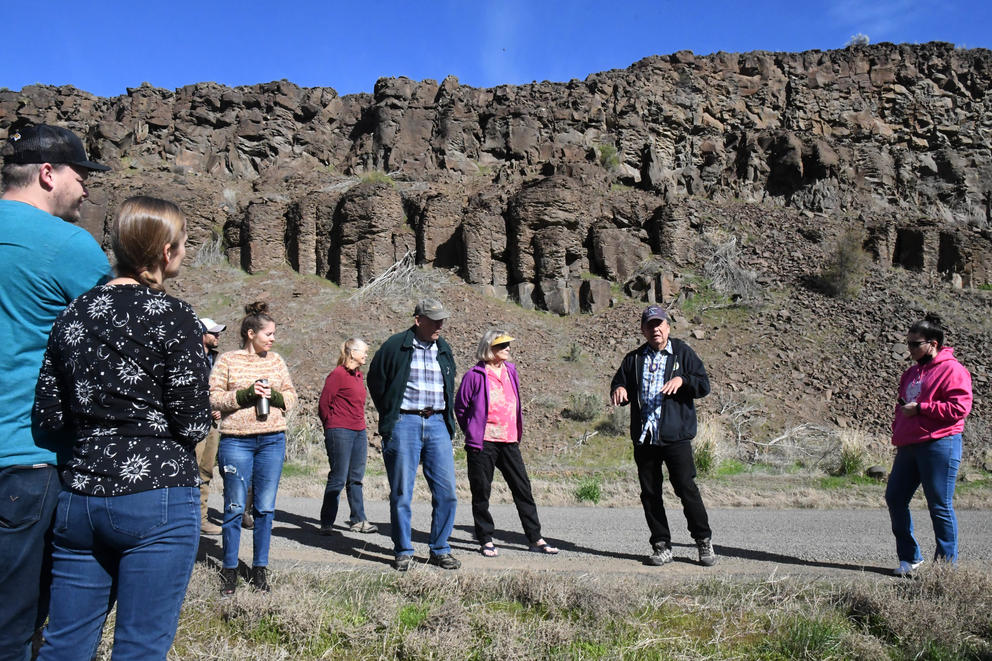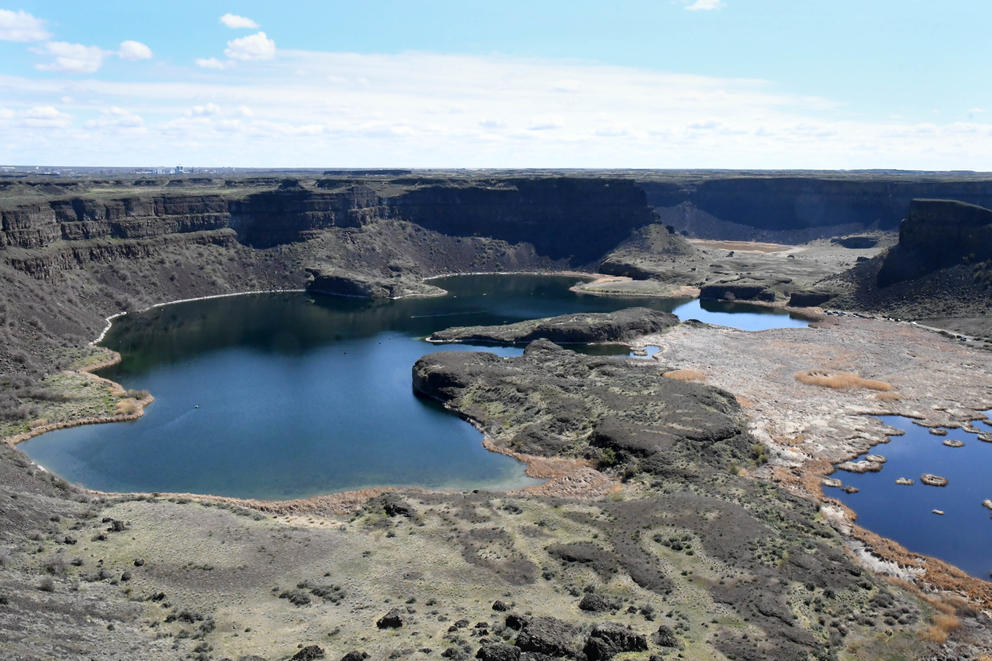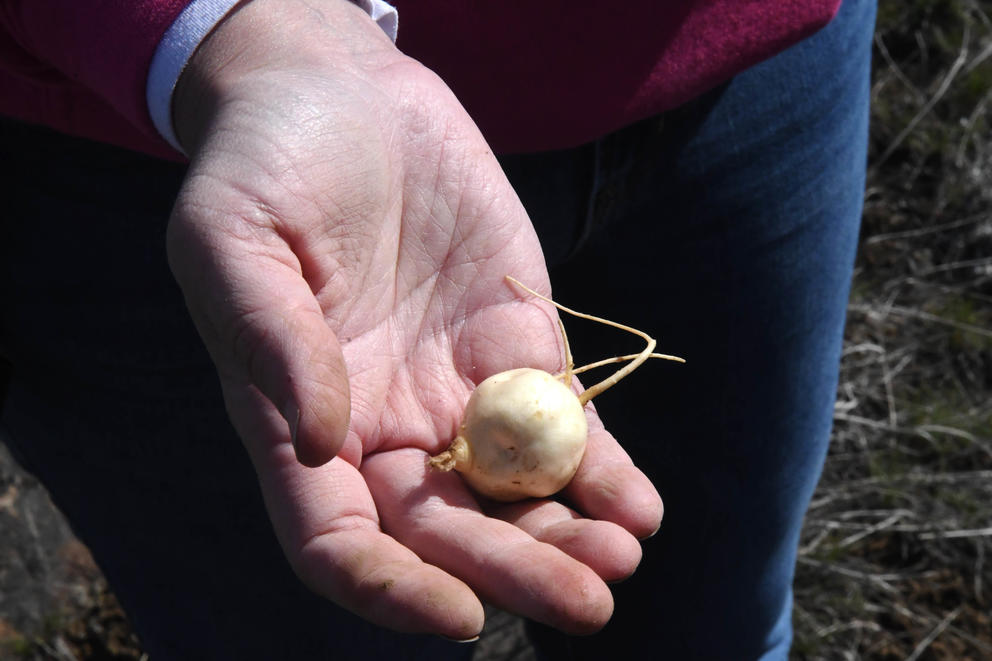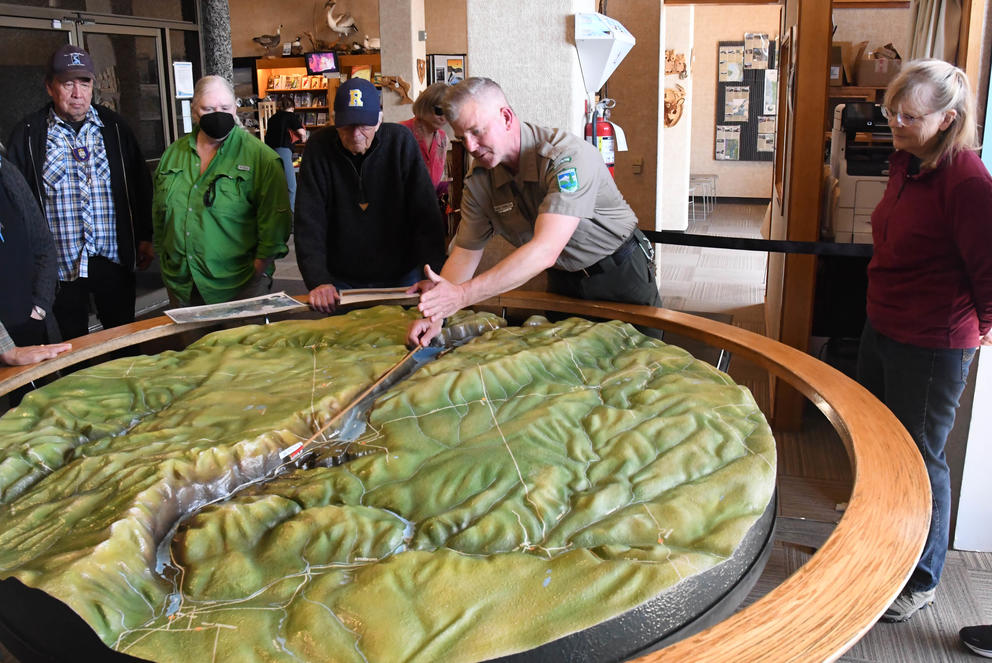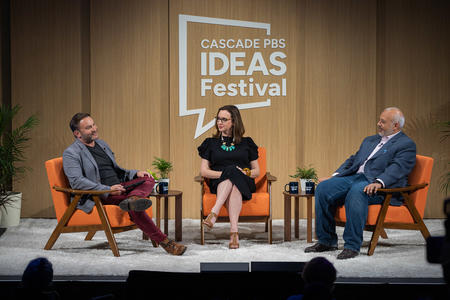Nearly every column, peak and unique geological structure in these canyons holds special meaning for the native peoples of the Moses-Columbia (or Sinkiuse) and Wenatchi (or P'Squosa) bands – two of the 12 that make up the Confederated Tribes of the Colville Reservation, where Lewis was born.
Lewis is an oral historian who was given a Peace and Friendship award by the Washington State Historical Society in 2019 for his work educating people about the tribes of the Inland Northwest. Each spring and summer, through the Wenatchee Valley Museum & Cultural Center, he leads day-long bus tours that highlight the region’s Native history and sacred sites. The first trip of this season was from Wenatchee to Grand Coulee, with stops at sites like Dry Falls and Steamboat Rock along the way.
In addition to the bus tours, Lewis has appeared in documentary films and worked in schools teaching children about the tribes.
At just about every turn, Lewis points to landmarks with names like “Coyote’s Card Table,” “Three Devils” or “Singing Rocks,” and explains their significance to the Sinkiuse and P'Squosa.
The Sinkiuse, or Columbia-Moses Nation, get their modern name from the river that gave them life and their most famous leader, Chief Moses. When Lewis’ ancestors roamed these lands, the coulee that would someday bear Moses’ name was used as a giant corral for the tribe’s horses.
Horses were incredibly valuable to the semi-nomadic tribes of the Inland Northwest, who traveled the region with the seasons and the migratory patterns of the fish and game they relied on for food. Lewis said each Sinkiuse lodge had an average of 150 horses. A lodge typically housed five or six people. In other tribes, it was common to have just six to 10 horses per lodge. Lewis said Moses’ people used the horses to trade and for dowries. He said the neighboring boys wanted to marry a Moses-Columbia girl because they would get a bunch of horses in the marriage.
As the bus wound its way north on a gravel road through Moses Coulee, it wasn’t hard to imagine warriors on their ponies riding along the ridges of the valley as Lewis described an encounter between the U.S. Army and Moses, one of the last war chiefs in the Washington Territory.
“This route is filled with stories,” Lewis said. “This is where Chief Moses encountered Colonial [George] Wright.”
Wright was a veteran of the Mexican-American war and an “Indian fighter” from the Second Seminole War. He would later rise to the rank of general in the Union Army during the Civil War. During his time in the Oregon Territory, he oversaw the construction of Fort Dalles and commanded forces that defeated the Indigenous people in the last battle of the Yakama War (1855–58), after which all the tribes of Eastern Washington were forced onto reservations. The day Lewis was remembering, however, Wright was there to arrest Chief Moses in connection with the death of some miners.
“So Colonel Wright comes up. He’s got a hundred and some men with him,” Lewis said. “And as they come up the valley here, Colonel Wright finds himself all of a sudden being hemmed in on both sides by Chief Moses, who’s got over 500 warriors all mounted, riding along the edge.”
Wright rode up to Moses, pointed to the sky, and said: “Nice day.”
Moses acknowledged Wright’s observation and then asked him a question: “Haven’t you got anything better to do today than die?”
Lewis said Wright decided he did and took his men back to The Dalles.
Passing the Rock Island Dam on the Columbia River, Lewis tells the creation story of the P’Squosa, or Wenatchi nation – his people.
“It goes back to the beginning of time. There was a covenant with the Creator that we would not be down here with all the animals,” he said.
At that time, Lewis said the P’Squosa village was high above the Columbia River at a place now known as Wenatchee Heights, about 1,870 feet above sea level.
“There was a prophecy that there would come a big flood. And that day came,” Lewis said. The people who lived below all died.
After the flood, Lewis said, the Creator chose the Coyote as his representative. The Coyote god is a central figure in the pantheon of deities revered by Western tribes, and is especially important to the P’Squosa and the other bands who make up the Confederated Tribes of the Colville Reservation. Coyote was known for being mischievous, clever and insatiable in his appetites for food and sex. As Lewis puts it: “He was a pervert.”
Coyote was also entrusted with finding a way to feed the people.
“So he went to the animal kingdom and requested volunteers,” he said. “Who’s going to feed the people?’”
The grizzly bear, cougar and wolf all refused. So Coyote and his brother Fox went down to the river and asked the otters, who also refused. They went to the giant beavers, who were busy building a dam at Rock Island, but they too refused.
“So all the way down the Columbia they went, Fox and Coyote,” Lewis said. “They got to the mouth of the Columbia and Coyote took his speaker staff and he smacked the water with it, sending out waves and sounds and bringing forth all the fish.”
Coyote implored the fish to help feed the people, but they refused. Frustrated, Coyote turned to Fox and said, “Well, I guess they’re going to starve.”
As they turned to leave they heard a small voice say, “We’ll help. We’ll help.” It was the salmon.
They had a couple of conditions, though. Man must have a ceremony and learn their songs before they eat the salmon. After man catches the salmon and eats them, he must not break any of their bones. He must return their unbroken bones to the water so their offspring will know where they come from. Finally, the salmon must be allowed to return to the ocean.
The Coyote promised and brought the salmon with him up the river, breaking the dams built by the giant beavers and by three witches known as the salmon sisters. Then he taught the people the ceremonies.
They thrived and prospered because of the salmon. Lewis said when the Lewis and Clark expedition came through the area, 13,000 to 16,000 Indigenous people inhabited the land from Rock Island to what is now East Wenatchee.
Now the region is home to some of the country’s most productive farms, orchards, vineyards and potato fields. Many were established by white families after the dams came back to the Columbia in the 1930s. This time they were built not by giant beavers or witches, but by the United States government.
With the new dams came hydroelectricity and – more important to farmers and ranchers – reliable irrigation for the region’s rich soil. The huge concrete structures harnessed the power of the water and ended the unmitigated movement of the sacred salmon.
Not far from the Rock Island Dam – the building of which resulted in the loss of sacred petroglyphs etched into the rocks of the Columbia thousands of years ago by Lewis’ ancestors – he pointed to a “nxweitlp,” or peak.
In the 1800s, his great-great uncle, or “topa,” was commanded by his grandfather to take him to the top of that peak. He was a young man, but it was still an arduous task, but he obeyed his grandfather and carried him all the way up.
“The old man looked out and said, ‘When the white people first came, our numbers were large. There were thousands of us. Now there’s 150 of us left.’”
Then Lewis sang a prayer that his great-great uncle, then a very old man, sang every night before bed for the rest of his life. He and the other children used to sit around him and sing the prayer together.
“The prayer was asking for help. To save us. Save our people,” he said. “What did we do that was so bad that you visited this upon us?”
Lewis’ history presentation rests on knowledge he has spent a lifetime pursuing. But the tour is also, at times, informal and spontaneous. At one point during a tour in April, he told the driver to make an unscheduled stop on the side of the gravel road, grabbed his “puca” (pronounced Pa-cha) – a root-digging stick traditionally made of antler or metal – and stepped out of the bus.
As he dug for a bulb called “cxelusa,” or biscuit root, a mainstay of the tribal diet, folks gathered around to watch and learn. After he found a couple of bulbs, he passed his puca around and let others try. The biscuit root was cleaned, cut up and sampled.
“This was our Trader Joe’s. This was our pharmacy,” Lewis said. “What we couldn’t get off of our lands we could trade to the other tribes and neighboring bands of Indians.”
Washington Interpretive Park Ranger David McWalter uses a 3-D model at the Dry Falls Visitor Center to explain how cataclysmic Ice Age floods carved out Grand Coulee, Dry Falls and the other coulees that make up the unique geology of the Channeled Scablands, on Saturday, April 22, 2023. (Dominick Bonny for Crosscut)
There is humor and sadness in the stories that Lewis tells, but there is also hope. He said his mother told him that the world we live in is like a great circle or a hoop. You can call it the sacred circle, or the medicine wheel, or the circle of life.
Since the coming of white men, through warfare, disease, imposed religion and the abuse children suffered at residential schools, parts of that circle have been broken. By coming together, talking and sharing knowledge, Lewis’s mother believed you could repair the circle.
“She said: ‘What is the opposite of dismember?’” he said. “‘Remember.’ Remembering is a very sacred thing. So when we come together as friends and as family we visit, we talk, we share. We remember and we heal that broken hoop.”

